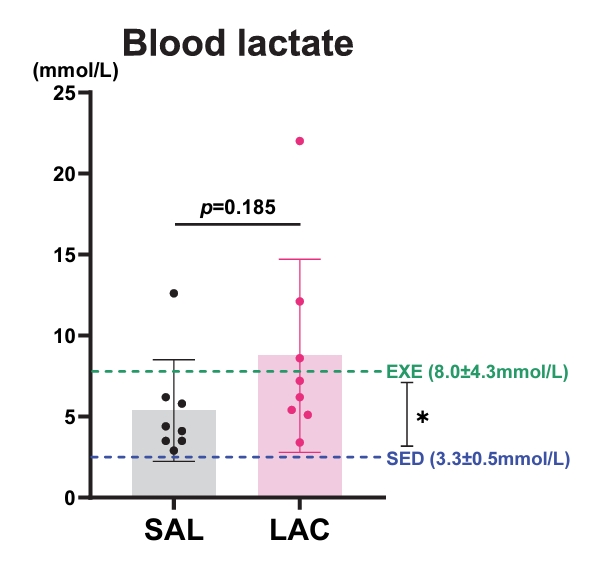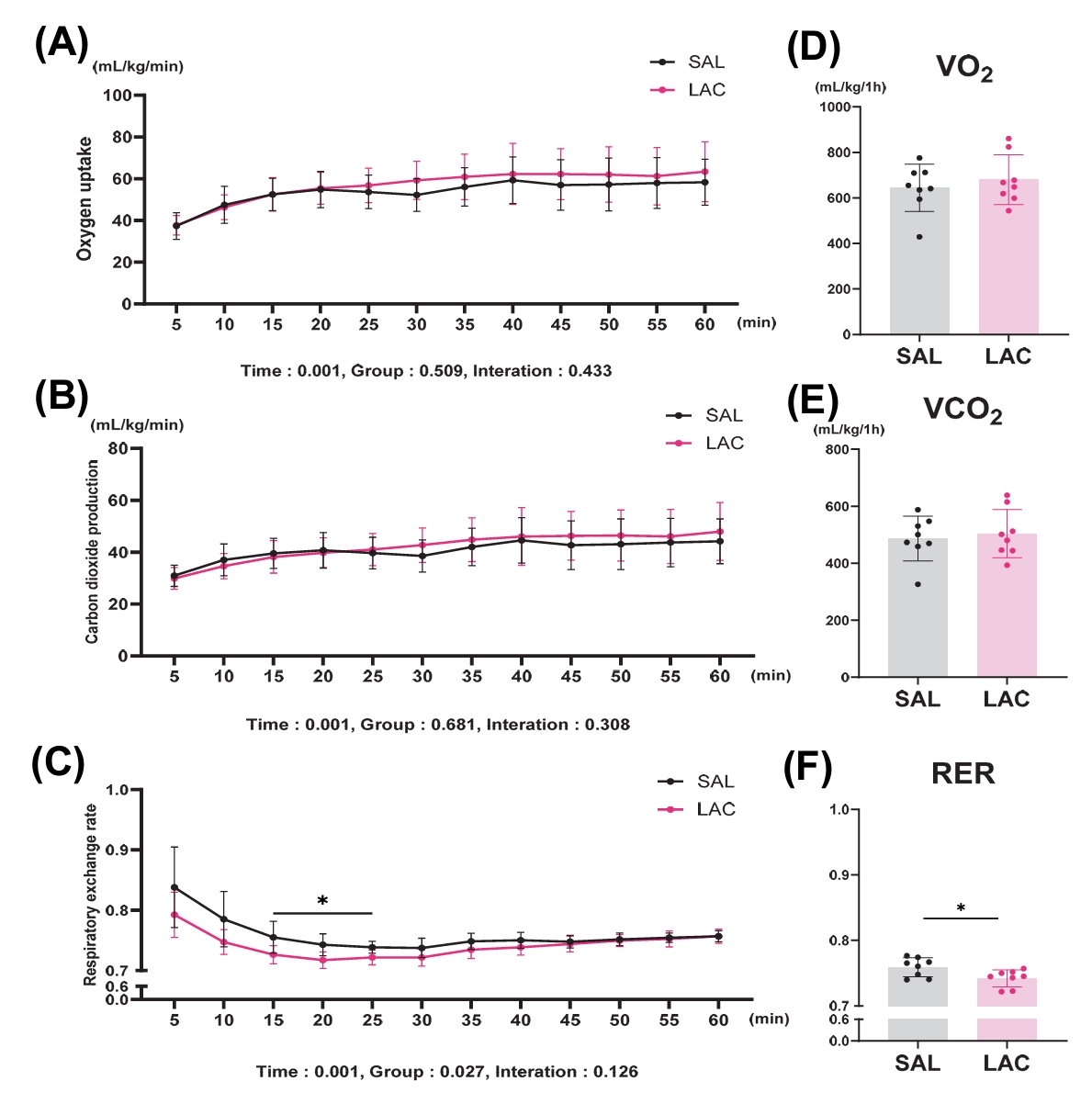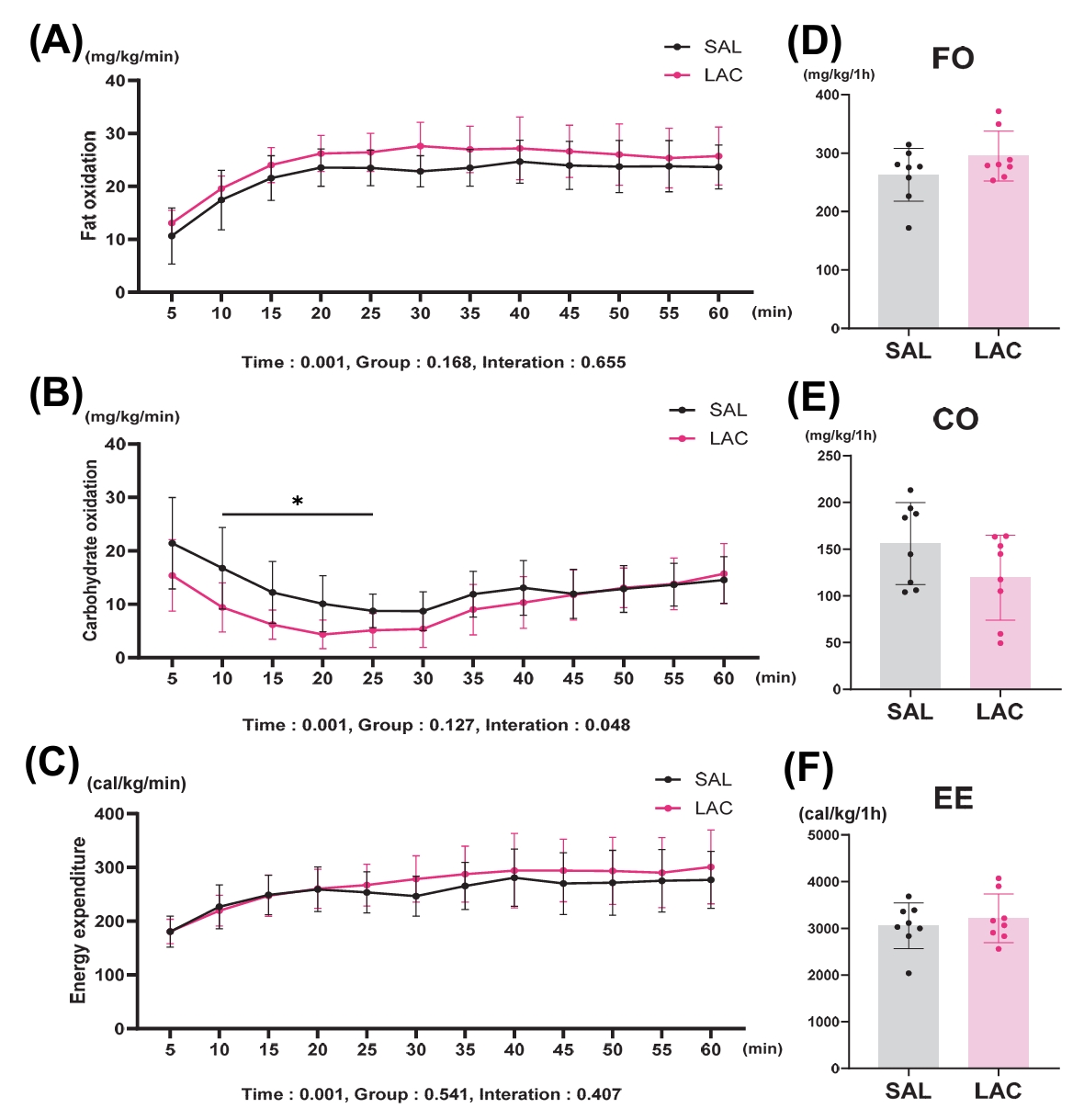 |
 |
- Search
| Phys Act Nutr > Volume 28(1); 2024 > Article |
|
Abstract
[Purpose]
This study investigated the effects of exogenous lactate intake on energy metabolism during 1 h of rest after acute exercise.
[Methods]
Eight-week-old ICR mice were randomly divided into four groups: SED (no treatment), EXE (exercise only), LAC (post-exercise oral lactate administration), and SAL (post-exercise saline administration) (n=8 per group). The exercise intensity was at VO2max 80% at 25 m/min and 15° slope for 50 min. After acute exercise, the LAC and SAL groups ingested lactate and saline orally, respectively, and were allowed to rest in a chamber. Energy metabolism was measured for 1 h during the resting period.
[Results]
LAC and SAL group mice ingested lactate and saline, respectively, after exercise and the blood lactate concentration was measured 1 h later through tail blood sampling. Blood lactate concentration was not significantly different between the two groups. Energy metabolism measurements under stable conditions revealed that the respiratory exchange ratio in the LAC group was significantly lower than that in the SAL group. Additionally, carbohydrate oxidation in the LAC group was significantly lower than that in the SAL group at 10-25 min. No significant difference was observed in the fat oxidation level between the two groups.
Excess post-exercise oxygen consumption (EPOC) is defined as the increased oxygen uptake during the post-exercise recovery period [1-3]. Assessing energy metabolism under EPOC conditions has shown significantly reduced respiratory exchange ratio (RER), increased fat oxidation level [4], decreased carbohydrate oxidation and increased lactate turnover rates [6], glycogen resynthesis [5]. Moreover, increased EPOC during the post-exercise period positively affects recovery [3].
In the 1970s, lactate was considered a byproduct of physical activity that caused fatigue [7-9]. Following the discovery of the Cori cycle, the lactate shuttle theory was established, changing our understanding of the physiological role of lactate. A recently published study described lactate function using three keywords [10]: lactate as an energy source, a gluconeogenesis precursor, and a signaling molecule, particularly during exercise, when lactate moves into or out of the cell. Lactate is a precursor of gluconeogenesis in the liver and used as an energy source, suggesting that it plays an important role in regulating energy metabolism during exercise.
Lactate regulates energy metabolism. Injecting 7-15 mg/min exogenous lactate into experimental animals (dogs) through intravenous catheterization for 40 min under stable conditions confirmed that fat oxidation decreased along with decreased blood free fatty acid (FFA) concentration [11]. In another study, injecting 2.5 mg/min exogenous lactate for 30 min through a clamp procedure in a resting group (adult men) decreased the RER. Moreover, during cycling exercise (VO2max 55%) continuous infusion of 10 mg/min exogenous lactate for 60 min spared glycogenolysis for blood glucose production and decreased RER [12]. Another study, ingesting exogenous lactate into experimental animals (mouse) before exercise and measuring their energy metabolism during 30 min of exercise (treadmill exercise at 18 m/min and 6° slope) observed an increase in RER [13].
Consequently, exogenous lactate contributes to energy metabolism regulation. In this study, we hypothesized that exogenous lactate intake could change energy metabolism after exercise. The experimental animals were trained to perform 50 min of acute high-intensity exercise (VO2max 80%). The animals ingested lactate orally, and the metabolic rates during a 1-h rest period were measured in a resting chamber to determine the effects on energy expenditure and fat and carbohydrate oxidation. To our knowledge, this is the first study to investigate the effects of lactate ingestion after exercise and observe changes in energy metabolism.
Eight-week-old male ICR mice (36.5±2.1 g, n=32) were purchased from Orient Bio (Seongnamsi, Gyeonggido, Republic of Korea) and randomly grouped in standard laboratory animal cages (4 mice/cage). The animals were housed under controlled conditions (12:12 h light: dark cycle; 50% humidity; temperature, 23±2 °C) with ad libitum access to standard rodent diet (Rodent type diet 5L79; Orient Bio) and water. This study was approved by the Institutional Animal Care and Use Committee of the Konkuk University (No. KU21233).
The mice were randomly divided into the following four groups (Figure 1): SED (no treatment), EXE (exercise only), LAC (post-exercise oral administration of lactate), and SAL (post-exercise oral administration of saline) (n=8 per group). The mice were allowed to adapt to the laboratory environment for 1 week, and exercise adaptation training was performed on an animal treadmill at a maximum speed of 15 m/min for 20 min for 3 days. Exercise intensity was set at 15° slope and 28 m/min (VO2max 80%) [13-16]. Lactate and saline water (3 g/kg) were orally administered to the LAC and SAL groups, respectively, immediately after the treadmill exercise [13,15,17].
To confirm the effect of post-exercise lactate intake on energy metabolic substrate utilization, we measured the resting metabolic rate 1 h in an open-circuit calorimetric chamber after substance administration [18,19]. Oxygen uptake and carbon dioxide production were measured using a mass analyzer (model RL-600, Alco System, Chiba, Japan) and a switching system (model ANI6-A-S; Alco System). The flow rate was maintained at 0.3 L/min. Oxygen uptake and carbon dioxide production were used to calculate the RER, carbohydrate oxidation, and fat oxidation.
All data were analyzed using IBM SPSS Statistics software (version 28.0; Armonk, NY, USA), and graphs were constructed using GraphPad Prism software (version 9.0). Significant differences between two or more groups at each time point were determined using two-way repeated analysis of variance (ANOVA). Post-hoc tests were performed using one-way repeated ANOVA and independent t-tests. The means were considered statistically significant at p < 0.05. Data are presented as means ± standard deviation (SD).
LAC and SAL group mice were administered lactate and saline, respectively, after exercise at the same intensity. After 1 h of rest, blood lactate concentration was measured by tail blood sampling, and was not significantly different between the LAC (8.7±5.9 mM) and SAL (5.4±3.1 mM) group mice (Figure 2; p=0.185).
The resting metabolic rates of mice were measured in a metabolic chamber for 1 h immediately after exercise. Oxygen uptake (VO2) and carbon dioxide production (VCO2) were not significantly different between the groups (Figure 3A, B). In contrast, although no significant interaction effects with RER were noted, a significant difference was confirmed between the LAC and SAL groups (Figure 3C; p=0.027).
The experimental animals rested for 1 h after the exercise, and the resting metabolic rate was measured in a metabolic chamber. No significant differences in the fatty acid oxidation levels were observed (Figure 4A). On the contrary, significant differences were observed in the level of carbohydrate oxidation between the LAC and SAL groups (Figure 4B; p=0.048). No significant differences were found between the two groups regarding energy expenditure (Figure 4C).
This study aimed to determine whether post-exercise exogenous lactate intake changes energy metabolism during recovery. We observed that a single oral administration of exogenous lactate decreased RER and carbohydrate oxidation rate. We speculate that exogenous lactate ingestion alters energy metabolism during post-exercise recovery.
Our analysis of blood lactate concentration using tail blood samples showed that this was high in the LAC group mice even after 1 h of rest after exercise (8.71 ± 5.9 mM), but the difference with the value recorded in the SAL group was not significant (p=0.185). In previous studies, blood lactate levels were maintained for up to 3 h [14,20,21], whereas no statistically significant differences were observed after 1 h. This result may be attributed to the differences in exercise intensity in this study. Most previous studies involved lactate ingestion after moderate-intensity (treadmill exercise at 15-25 m/min and 6-10° slope) exercise, whereas this study involved high-intensity exercise (exercise at 15° slope and 28 m/min). Consequently, the turnover rate of lactate in the blood appears to have increased.
Increased glycogen resynthesis during EPOC [5]. In this study, we observed that carbohydrate oxidation decreased when subjects ingested exogenous lactate after exercise. A previous study confirmed that the intraperitoneal administration of exogenous lactate after exercise increased the expression level of FBP-1, a catalytic enzyme involved in glucose formation [21]. In another study, MCT-1 expression levels increased when exogenous lactate was ingested after exercise for 3 weeks [20]. Other studies have also confirmed that glycogen concentration increased in type-1 muscle fibers [20,22]. Based on these findings, it appears that the energy metabolism results obtained in this study are related to increased glycogen concentration.
The effects of lactate supplementation differ depending on the timing of its ingestion. Previous studies have reported that when exogenous lactate is ingested before exercise, carbohydrate oxidation increases and glycogen concentration significantly reduces after exercise [13]. When the participants ingested exogenous lactate after exercise for 4 weeks, VO2max increased during exercise. Consequently, it appears that 4 weeks of exogenous lactate ingestion increased fat oxidation rate and skeletal muscle synthesis as well as improved endurance exercise capacity [23].
Notably, lactate produced in the body leads to decreased fatty acid oxidation and, conversely, increased carbohydrate oxidation [10]. A previous study has shown increased fat oxidation after exogenous lactate ingestion at rest [24]. This is presumedly because the lactate produced during stable conditions increase the blood lactate concentration and turnover rate due to exogenous lactate ingestion, which influences changes in energy metabolic substrates through additional energy synthesis. Thus, changes in energy metabolism depend on not only the timing of lactate ingestion, but also the route of lactate supply.
In conclusion, post-exercise exogenous lactate intake lowered the 1-h RER and carbohydrate oxidation during rest. Reduced carbohydrate oxidation levels suggest that carbohydrates may be mobilized as energy sources. This study proposes that exogenous lactate can be considered an exercise aid to improve energy supply after exercise, and a co-treatment of energy supplements taken after exercise and exogenous lactate appears to confer the benefit of rapid energy recovery. This study has some limitations. It was a piecemeal study that only measured the effects of lactate for maximum 1 h during a single treatment. To utilize exogenous lactate as an exercise aid, additional studies are required to elucidate the underlying mechanisms.
Acknowledgments
This work was supported by the Ministry of Education of the Republic of Korea, National Research Foundation of Korea (NRF-2023S1A5A8080047 and NRF-2021R1G1A1011987), and KU Research Professor Program of Konkuk University.
The authors declare no competing interests.
Figure 1.
The schematic representation of experimental procedure.
Experiments were initiated with Eight-week-old male ICR mice (n=32). This study was designed to observe the effects of exogenous lactate treatment at post-exercise (SED, no treatment group; EXE, exercise only group; LAC, post-exercise oral administration of lactate group; SAL, post-exercise oral administration saline group; n = 8), Blood icon; measurement of blood lactate concentration.

Figure 2.
Blood lactate concentration 1 h after oral administration of 3g/kg lactate to SAL (saline administration) and LAC (lactate administration) group mice.
For the SED(no treatment) and EXE(exercise only) group mice, blood lactate was measured without any treatment and immediately after exercise, respectively (n = 8 per group).

Figure 3.
Effect of post-exercise exogenous lactate intake.
Resting metabolic rate measured after energy substrate utilization for 1 h. A. Oxygen uptake, B. carbon dioxide production, C. respiratory exchange rate, D. total oxygen uptake for 1 h, E. total carbon dioxide production for 1 h, F. average respiratory exchange rate for 1 h. Values are presented as means ± standard error of the mean (n = 8 per group). SAL, saline administration group; LAC, lactate administration group.

Figure 4.
Effect of post-exercise exogenous lactate intake.
Resting metabolic rate measured after energy substrate utilization for 1 h. A. Fat oxidation, B. carbohydrate oxidation, C. energy expenditure, D. total fat oxidation for 1 h, E. total carbohydrate oxidation for 1 h, F. total energy expenditure for 1 h. Values are presented as means ± standard error of the mean (n = 8 per group). SAL, saline administration group; LAC, lactate administration group.

REFERENCES
1. Smith J, Naughton LM. The effects of intensity of exercise on excess postexercise oxygen consumption and energy expenditure in moderately trained men and women. Eur J Appl Physiol Occup Physiol 1993;67:420-5.



2. Foureaux G, Pinto KMC, Dâmaso A. Effects of excess post-exercise oxygen consumption and resting metabolic rate in energetic cost. Rev Bras Med 2006;12:393-8.
3. Børsheim E, Bahr R. Effect of exercise intensity, duration and mode on post-exercise oxygen consumption. Sports Med 2003;33:1037-60.


4. Kern M, Broder HD, Edmondson JI, Cannon DT. Diet composition does not alter energy expenditure, substrate metabolism, or excess post-exercise oxygen consumption in healthy, non-exercise trained women. Nutr Res 2007;27:665-71.

5. Bahr R, Ingnes I, Vaage O, Sejersted OM, Newsholme EA. Effect of duration of exercise on excess postexercise O2 consumption. J Appl Physiol 1987;62:485-90.


6. Thornton MK, Potteiger JA. Effects of resistance exercise bouts of different intensities but equal work on EPOC. Med Sci Sports Exerc 2002;34:715-22.


7. Wasserman K. The anaerobic threshold measurement to evaluate exercise performance. Am Rev Respir Dis 1984;129:S35-40.


9. Gladden LB. Lactate metabolism: a new paradigm for the third millennium. J Physiol 2004;558:5-30.



10. Brooks GA, Arevalo JA, Osmond AD, Leija RG, Curl CC, Tovar AP. Lactate in contemporary biology: a phoenix risen. J Physiol 2022;600:1229-51.



11. Miller HI, Issekutz B Jr, Rodahl K, Paul P. Effect of lactic acid on plasma free fatty acids in pancreatectomized dogs. Am J Physiol 1964;207:1226-30.


12. Miller BF, Fattor JA, Jacobs KA, Horning MA, Navazio F, Lindinger MI, Brooks GA. Lactate and glucose interactions during rest and exercise in men: effect of exogenous lactate infusion. J Physiol 2002;544:963-75.




13. Jang I, Kim J, Kyun S, Hwang D, Lim K. Acute administration of exogenous lactate increases carbohydrate metabolism during exercise in mice. Metabolites 2021;11:553.



14. Hwang D, Kim J, Kyun S, Jang I, Kim T, Park HY, Lim K. Exogenous lactate augments exercise-induced improvement in memory but not in hippocampal neurogenesis. Sci Rep 2023;13:5838.




15. Yoo C, Kim J, Kyun S, Hashimoto T, Tomi H, Lim K. Synergic effect of exogenous lactate and caffeine on fat oxidation and hepatic glycogen concentration in resting rats. Phys Act Nutr 2022;26:5-13.




16. Kim N, Kim J, Lim K, Park J. Role of dihydrotestosterone in wholebody energy utilization during acute running exercise in mice. J Exerc Nutrition Biochem 2018;22:7-11.

17. Lezi E, Lu J, Selfridge JE, Burns JM, Swerdlow RH. Lactate administration reproduces specific brain and liver exercise-related changes. J Neurochem 2013;127:91-100.




18. Lim KW, Kim JS, Jeon YR, Hwang HJ, Suh HJ. Orignal paper: measurement of resting metabolic rate using metabolic chamber in resting rats. Phys Act Nutr 2011;15:35-40.
19. Kim J, Hwang H, Yun HY, Kim B, Lee CH, Suh H, Lim K. Silk peptide intake increases fat oxidation at rest in exercised mice. J Nutr Sci Vitaminol (Tokyo) 2013;59:250-5.


20. Hoshino D, Hanawa T, TAkAHASHI Y, Masuda H, Kato M, Hatta H. Chronic post-exercise lactate administration with endurance training increases glycogen concentration and monocarboxylate transporter 1 protein in mouse white muscle. J Nutr Sci Vitaminol (Tokyo) 2014;60:413-9.


21. Takahashi K, Kitaoka Y, Matsunaga Y, Hatta H. Effect of post-exercise lactate administration on glycogen repletion and signaling activation in different types of mouse skeletal muscle. Curr Res Physiol 2020;3:34-43.



22. Kitaoka Y, Hoshino D, Hatta H. Monocarboxylate transporter and lactate metabolism. J Phys Fit Sports Med 2012;1:247-52.

-
METRICS

-
- 0 Crossref
- Scopus
- 535 View
- 11 Download
- Related articles in Phys Act Nutr
-
Glucose administration on energy substrates utilization during exercise2000 March;4(1)
Effects of Acute Administration of Carnitine on Energy Utilization in Trained Rats1998 June;2(2)





